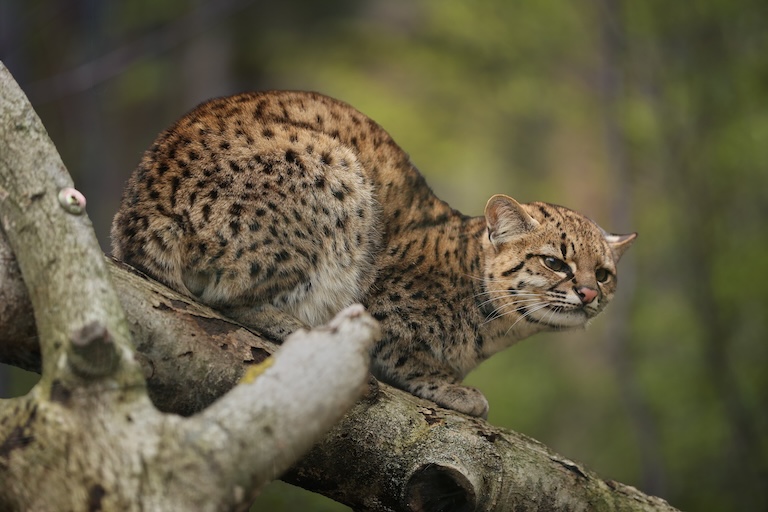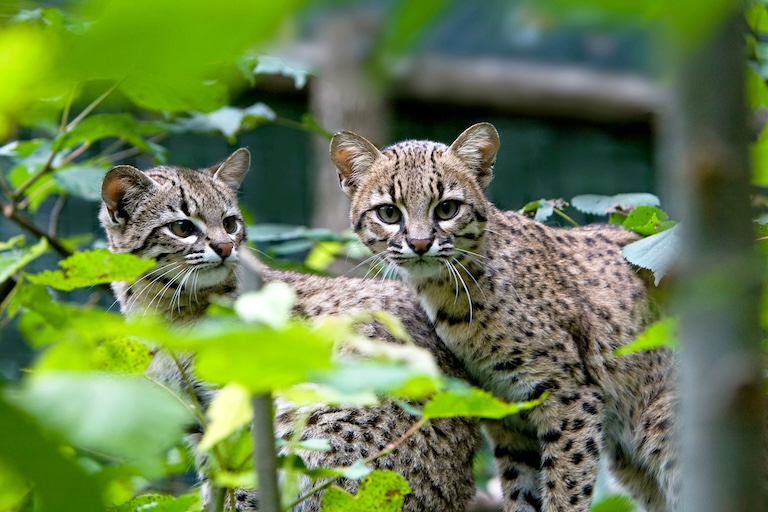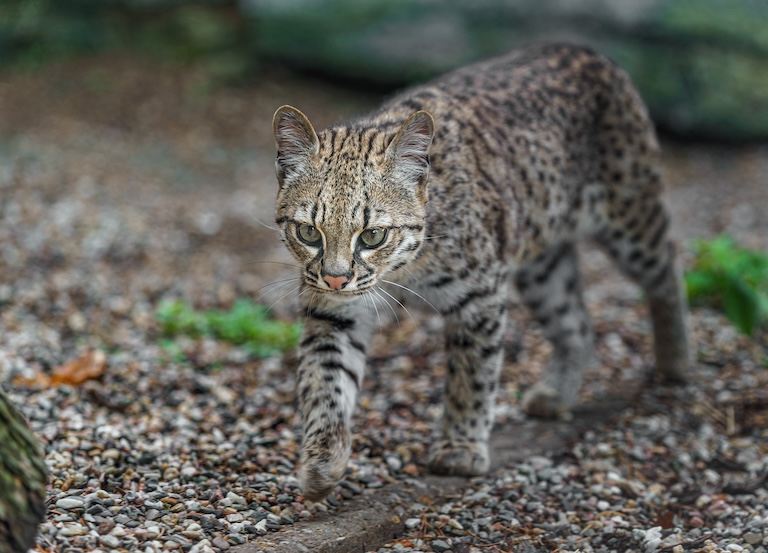Geoffroy’s Cat Profile
Cats are highly elusive animals, so it’s hard to say where most of them live because it’s likely some are yet to have been described, but there’s no question that Asia and South America are home to the most species known.
There are around 45 species in the Felidae family, and while the most famous are African cats, this continent only has around 10 species.
South America, despite being just 59% the size of Africa, has around 14 species of cat, at least 11 of them being small wild cats in the subfamily Felinae.
The majority of these are in the Leopardus genus, and this is where Geoffroy’s cat, a tiny, house cat-sized feline sits.

Geoffroy’s Cat Facts Overview
| Habitat: | Varied: scrubby woodland, dry forests and savannas, desert, grasslands |
| Location: | Mostly Argentina, Bolivia, some parts of Uruguay and Brazil, Chile |
| Lifespan: | 16 years in captivity |
| Size: | Up to 75 cm (30 in) with a 40 cm (16 in) tail |
| Weight: | Average 4.3 kg (9.5 lb), maximum 7.4 kg (16 lb) in large males |
| Colour: | Brown or golden base colour with dark spots, stripes and bands on neck and tail |
| Diet: | Primarily small rodents, also birds, vizcachas, hares |
| Predators: | Pumas, caiman, jaguars, foxes, raptors |
| Top Speed: | Unknown |
| No. of Species: | 1 |
| Conservation Status: | Least Concern (IUCN) |
Geoffroy’s cat is one of a bunch of cats that radiated into South America through the Isthmus of Panama, having migrated all the way from Asia.
Diversifying into their new continent, they now dominate the cat species as the genus Leopardus, and true to their kind, Geoffroy’s cats are incredibly adaptable animals, suited to a multitude of habitats and altitudes.
While they were once hunted for their fur, they have since been left alone and bounced back well.
Interesting Geoffroy’s Cat Facts
1. They’re in the cheetah group
Despite the misleading genus name Leopardus, these little cats are not in the large cat subfamily where the leopard resides, but in the more petite group – a subfamily called Felinae.
This contains the familiar house cats and similar-sized felines, but also animals as large as the puma and cheetah. These cats are known for their ability to purr, and their lack of ability to roar.
These cats originate from Asia – and many species are still there – but this one comes from a line of migrants that crossed over to North America during the Miocene and then into South America when it bumped into North America a little while later.
The Leopardus genus diverged around this time, likely as it radiated into the continent and is now the most diverse genus of the small cats found in South America, making up nine of the 11 Felinae species (the puma, or cougar, while it is a big cat, is not a Big Cat – i.e. from the Panthera genus).
Geoffroy’s cat appears to be most closely related to the Kodkod and forms a clade with that species and the Oncilla, its next relative.

2. They’re highly adaptable
This cat has an incredible range that spans much of South America, from Central Bolivia all the way down to the South of Argentina. It owes its success to its ability to thrive in a variety of habitats, ranging from dry mountain grasslands to flooded coastal habitats and forests.
It’s found in urban and agricultural landscapes, too, and thrives more or less anywhere there’s a little cover.
A big part of this adaptability is the result of pressure from larger predators, as Geoffroy’s cat is about the size of a domestic cat, and shares its range with some real monsters like the Jaguar. Being able to move between habitats helps keep them out of trouble.
It’s not only distance they can span, but also altitude. This species is found from sea level, all the way up to 3,800 metres! 1
3. They’re solitary but tolerant
In the wild, these cats live a solitary life, rarely hanging out with other members of the species unless they’re mating or looking after their offspring: females are seen with kittens, but this is the only time groups are spotted.
But while they choose a quiet life, they’re not unkind to one another in captivity, and will happily make friends, groom and socialise with one another.
4. They have toilets
While the family cat is well known for digging up your flower beds to poop, Geoffroy’s cat isn’t as ashamed of its biological functions and will not bury its faeces.
This species will, however, choose a specific latrine site, to which it will return multiple times. These are usually on tree platforms, rock shelters, or tufts of grass and they’re thought to be landmarks and communication points between conspecifics.
In captivity, a Geoffroy’s cat sniffing another cat’s toilet will then make a very funny grimace that looks a lot like it’s regretting the decision, but this is known as the flehmen response and is a way of spreading the scent across the contact surface in the nose to analyse it more intricately.
This is common in mammals; when you see horses pulling a funny face, this is usually what they’re doing.
Not a lot more is known about their communication methods, but in captivity, they’re said to produce a “gurgle bo” sound when expressing friendliness. 2 3
5. They’re active
Another mode of their success comes from their energy in pursuit of food. They’re mostly nocturnal in the wild, and crepuscular in captivity, but they will increase their daytime activity relative to how much food they need.
Males can travel over three kilometres in a night, and they increase general activity in relation to human disturbances.

6. They were hunted for fur
This cat, while widespread, is still an elusive animal, and there’s a clear lack of literature relative to how common the species is. Still, it isn’t so rare to have avoided human hunters, and from the 1960s to the 1980s, it was hunted intensively for its fur.
This species was (and still is) also persecuted as a pest and for the illegal pet trade, but aside from the rampant deforestation facing the continent, human-related threats appear to have died down.
Ranchers still kill them, as do domestic dogs and collisions with cars, but the species is doing quite well and is of least concern to the IUCN. 4
Geoffroy’s Cat Fact-File Summary
Scientific Classification
| Kingdom: | Animalia |
| Phylum: | Chordata |
| Class: | Mammalia |
| Order: | Carnivora |
| Family: | Felidae |
| Genus: | Leopardus |
| Species: | geoffroyi |
Fact Sources & References
- Nicole Kaminski, “Leopardus geoffroyi Geoffroy’s cat”, Animal Diversity Web.
- Dr. Louise Barnes MRCVS (2023), “What Is The Cat Flehmen Response?”, Cats.com.
- Benjamin L Hart (1987), “Stimulus and hormonal determinants of flehmen behavior in cats”, Research Gate.
- “Geoffroy’s Cat”, IUCN Red List.
